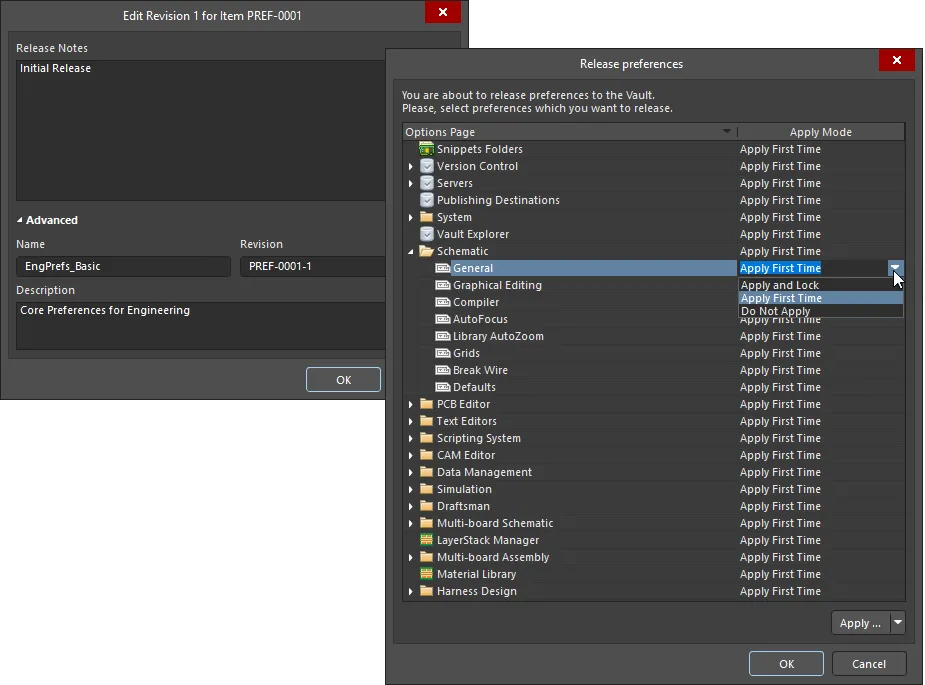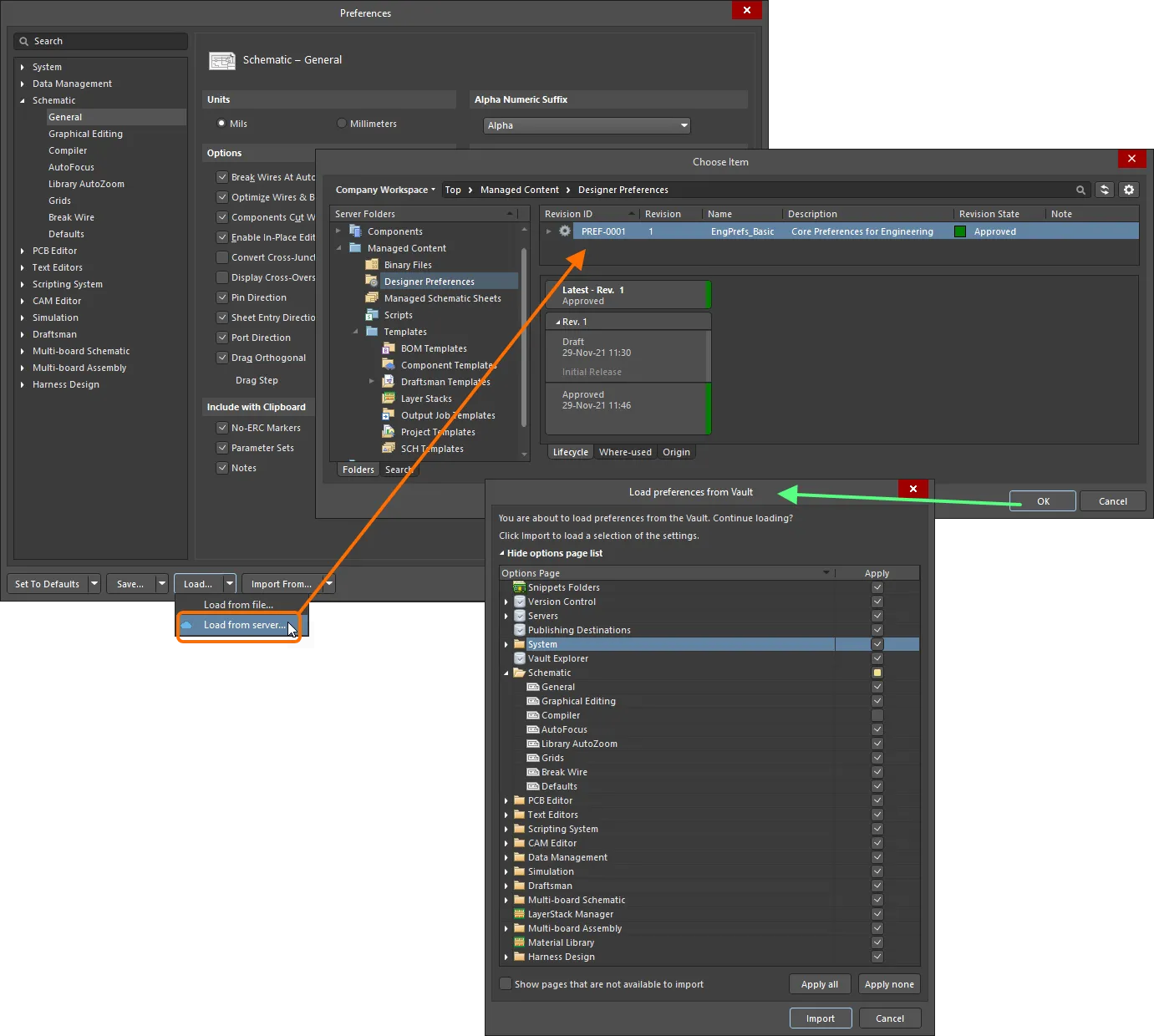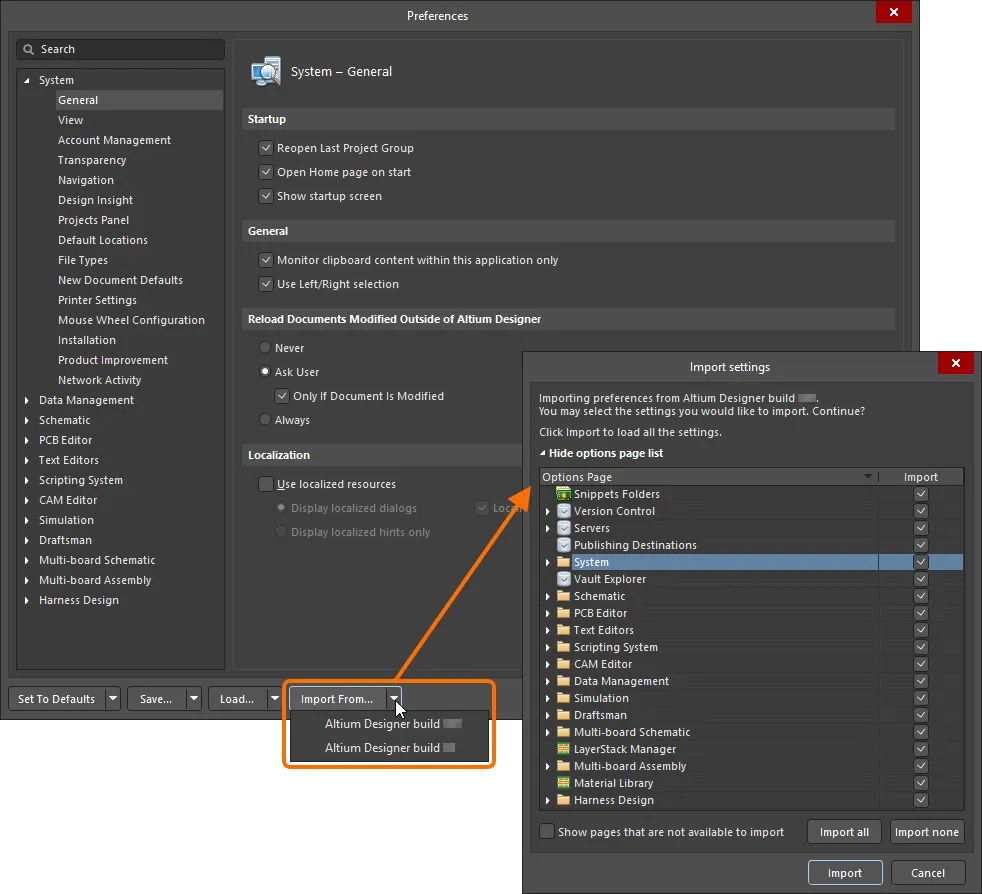Your Altium Designer software provides a central location from where you can set up various preference settings for the Altium Designer environment, as well as global options specific to various editors and their features. These are global system settings that apply across projects and relevant documents.
Configuration of preferences is performed from within the Preferences dialog, accessed by clicking on the  control at the top-right of the design space.
control at the top-right of the design space.
 Access to the Preferences dialog - control central for setting global system and editor-specific settings.
Access to the Preferences dialog - control central for setting global system and editor-specific settings.
Preferences are clustered into categories. Click on a category name on the left-hand side of the dialog to open the selections for that category. Click on an entry within a category to present the detailed page for that area on the right. The banner at the top of the region will display the name of the page being edited, in the format <CategoryName> - <ChildPageName>. Use the controls and options available on a loaded page to configure your preferences for that area of the software as required. This could be a mixture of satisfying company policy and your preferred working environment.
- When connected to a Workspace, a green icon (
 ) appears next to Data Management Preferences pages that are subject to the Workspace's control.
) appears next to Data Management Preferences pages that are subject to the Workspace's control.
- When a change is made to an option on a preference page, that page's entry will be distinguished in the left-hand pane by becoming bold and an asterisk (*) displayed to the right of its name.
Preference Categories
The following categories of preferences are available:
Resetting Preferences to Their Defaults
The Preferences dialog provides an ability to set the options and controls on the selected preferences page, pages of the selected category, or all pages, back to their defaults. Click the Set To Defaults button at the bottom of the dialog and select one of the following commands:
- Default (Page) – use to set the options and controls on the selected child preferences page back to their defaults.
- Default (Branch) – use to set the options and controls on all child preferences pages of the selected category back to their defaults. Ensure the desired parent category folder is selected; otherwise, this command will be unavailable.
- Default (All) – use to set the options and controls on all preferences pages back to their defaults.
When
uninstalling Altium Designer, you can also opt to remove just the preferences-based folders, covering system application data and security files, user application data files, and user local application data, by selecting the
Remove Preferences option in the
Altium Designer Uninstaller wizard.
Saving and Loading Preferences
The Preferences dialog allows you to save preferences to and load preferences from a Preferences file or a Design Preferences Item in your Workspace.
Saving and Loading Preferences using a Preferences File
To save your preferences to a Preferences file (*.DXPPrf), click the Save button at the bottom of the Preferences dialog and select Save to file. A dialog will open in which you can select the location and name of the file.
To load preferences from a Preferences file, click the Load button at the bottom of the Preferences dialog and select Load from file. The Load Preferences dialog will appear from where you can browse to and open the desired file.
Saving and Loading Preferences using a Connected Workspace
To save your preferences to a connected Workspace, click the Save button at the bottom of the Preferences dialog and select Save to server. The Choose Item dialog will appear – use this to choose an existing Designer Preferences Item to save preferences to its next revision.
If the target Designer Preferences Item doesn't exist, you can create it through the Choose Item dialog on-the-fly in the chosen Workspace folder by right-clicking in the revision list region of the dialog (or, if the folder does not contain any item yet, by clicking the Add an item control) and selecting the Create Item » Altium Designer Preferences command.

Saving the currently defined preferences for your active instance of Altium Designer, to a planned revision of a target Designer Preferences Item, in a Workspace.
After choosing the required target Item Revision, click OK – the Edit Revision dialog will appear, in which you can change Name, Description, and add release notes as required. Clicking OK to proceed will present the Release preferences dialog. This dialog is used to manage the way in which the range of Altium Designer preferences is released to the targeted revision of the designer preferences.

Edit the revision as required, including adding release notes, then proceed to define how the preferences are released, through the Release preferences dialog. The mode in which preferences/settings are released will determine their accessibility when later reusing the revision of the designer preferences.
The dialog presents an entry for each of the pages of options found in the Preferences dialog, along with entries for the following range of additional (and useful!) Altium Designer settings:
Customizations (under System) – user interface customizations (menus, shortcuts, buttons, etc.).Item Manager (under System) – Item update settings.Vault Explorer – settings relating to the Explorer panel.View Configurations (under PCB Editor) – layer colors and activation, custom display configurations.Snippets Folders (under PCB Editor) – target folders for design Snippets.LayerStack Manager – settings relating to the Stackup Editor.Material Library – settings related to the materials library, used when defining a layer stackup in the Stackup Editor.
The dialog offers three applicable modes – Apply Modes – for how preferences will be applied to Altium Designer when the revision of the designer preferences is loaded from the Workspace:
- Apply and Lock – the preferences/settings will be loaded in Altium Designer as read only (uneditable) options. They will return to an editable state when the user is no longer connected to the Workspace.
- Apply First Time – the preferences/settings will be loaded in Altium Designer as initial settings, which can be edited by the user.
- Do Not Apply – the preferences/settings will not be loaded in Altium Designer, allowing the existing settings to remain.
The distinction between the two Apply modes (above) is most useful when a revision of a Designer Preferences Item will be added to an
Environment Configuration, where the preferences will be automatically applied when a user connects to the Workspace and chooses to use that configuration.
All of the additional settings, with the exception of Customizations, can only be set to Apply First Time, or Do Not Apply.
The Apply Mode can be defined:
- For an individual entry, by clicking within the corresponding Apply Mode cell and choosing the required mode from the drop-down menu.
- For all entries in an expandable section/category, by clicking within the corresponding Apply Mode cell for that section's/category's entry and choosing the required mode from the drop-down menu.
- For all entries in a single sweep, by using the menu associated to the Apply button, at the bottom-right of the dialog.
An entry of Custom at a section/category level means that the child entries are at differing mode levels.
Once you have defined the modes as required click OK – the release will proceed, with the preferences stored in the revision of the target designer preferences. The released data stored in the revision consists of configuration settings files for preferences pages, and associated settings files for application look and feel, all tidily contained in a single zip file – preferences.zip.
If you need to change the preferences set stored in a Designer Preferences Item, make changes to the active preferences as required, then save those preferences to the next planned revision of that Item.
Downloading a Preferences File
Download the Preferences zip file (preferences.zip) stored in a revision of a Designer Preferences Item, by right-clicking on that revision in the Explorer panel and choosing the Operations » Download command from the context menu. The file will be downloaded into a sub-folder under the chosen directory, named using the Item Revision ID. The file can be found in the Released folder therein. The zip includes:
- A configuration settings file (
*.ini) for each preferences page whose Apply Mode (on release of the revision) was set to Apply First Time, or Apply and Lock.
- Files relating to any of the additional settings whose Apply Mode (on release of the revision) was set to Apply First Time. These could include, for example:
- Object defaults (
ADVPCB.DFT, Sch_DefPrimitives.dft, Sch_DefPrimitives.MMsdft, PcbDrawing_Primitives.xml)
- 2D and 3D view configuration files (
*.config_2dsimple, *.config_3d)
- PCB Color templates (
*.PCBSysColors)
DXP.RAFDXP.RCSUserTools.TLT
Access the Download command from the top-level entry for a Designer Preferences Item itself, to download the preferences file stored in the latest revision of that Item.
When connected to your Workspace, you are free to reuse the revisions of any designer preferences available for you. The ability to load preferences stored in a local file (*.DXPPref) also remains available, should you need to use this.
If you do not connect to your Workspace, you can still work with Altium Designer (under your valid Altium Designer license), but you will not be able to access that Workspace or any other services it provides. You will, therefore, not be able to reuse any Workspace-based designer preferences. You will only be able to use file-based preferences defined locally.
To load a revision of designer preferences from your Workspace to Altium Designer, choose the Load from server command from the Load drop-down menu in the Preferences dialog, and then choose the desired Item Revision through the Choose Item dialog. After clicking OK, the Load preferences from Vault dialog will appear. The dialog reflects the exact setup that you defined for each preferences/settings entry – through the Release preferences dialog – when the revision was released.

Manually choosing a revision of designer preferences, whose defined preferences/settings are to be applied to Altium Designer. Check, and adjust if necessary, the preferences/settings that will be loaded from the Workspace, using the Load preferences from Vault dialog.
-
 – entity is either set to Apply and Lock or Apply First Time.
– entity is either set to Apply and Lock or Apply First Time.
-
 – entity is set to Do Not Apply.
– entity is set to Do Not Apply.
The

icon reflects the custom nature of a section/category (the child entries are at differing Apply mode levels).
Click Import to have the preferences, as defined in the Item Revision, applied to your instance of Altium Designer. Should you wish, you can make changes – overriding on-the-fly – by toggling the Apply state for an entity. Note that if you enable an entity that was set as Do Not Apply, it will become Apply First Time.
The preferences will load with a dialog indicating progress. A final dialog will appear after the process is finished, alerting you to the fact you may need to restart Altium Designer for changes to menus, toolbars, or locale to take effect.
A Preferences page set to Apply and Lock during the release, in the Release preferences dialog, will be set to read-only when the revision of the designer preferences is loaded in Altium Designer. This is indicated by the symbol  displayed at the top-right of the page, and also the symbol
displayed at the top-right of the page, and also the symbol  to the right of the page's entry in the main tree (at the left of the Preferences dialog).
to the right of the page's entry in the main tree (at the left of the Preferences dialog).

Preferences that have been released as Apply and Lock will be read-only for the current session when reloaded in Altium Designer.
Such pages will remain locked while the user is connected to the Workspace, for only that session.
Preferences that were set to Do Not Apply during release are unaltered in Altium Designer when the preferences are loaded.
Reusing a Design Preferences Item as Part of an Environment Configuration
A released preferences set can also be used as a configuration data item in one or more defined Environment Configurations. An environment configuration is used to constrain a designer's working environment to only use company-ratified design elements. Environment configurations are defined and stored within the Team Configuration Center – a service provided through the Workspace. For more information, see Environment Configuration Management (Altium 365 Workspace, Enterprise Server Workspace).
Once you have connected to the Workspace, and chosen (if applicable) from the selection of environment configurations available to you, Altium Designer will be configured, with respect to use of preferences. If the chosen environment configuration has a defined Designer Preferences Item revision, then that is applied straight away. If the chosen environment configuration applicable to you does not have a Designer Preferences Item revision specified, then preferences will remain manually definable. In other words, you are free to manually reuse a revision of a Designer Preferences Item, or use a locally saved preferences file.
Under the enforcement of an environment configuration that includes a revision of a Designer Preferences Item, Altium Designer’s existing preferences settings will be replaced by those enabled in that revision – those that were set to Apply First Time, or Apply and Lock. Preferences that were set to Do Not Apply are left unaltered when the configuration is applied and the preferences loaded.
If preferences were set to Apply First Time when originally released to the Item revision in the Workspace, they will only be applied once when those preferences are subsequently loaded in Altium Designer. When the connected user then changes those preference options, they will not be overwritten the next time the user connected to the Workspace.
Note that the preferences management menus (at the bottom of the Preferences dialog) are disabled, with the exception of the Save commands.
Importing Preferences from a Previous Altium Designer Version
To load preferences from previous versions of Altium Designer, click Import From at the bottom of the dialog. The associated menu will list all previous versions/releases currently installed on the computer from which preferences can be imported. After selecting the required version, the Import settings dialog will open in which you can choose to import preferences from the selected installation.

Import settings from your previous version's installation.
Preferences can be imported from any individually installed version instance of Altium Designer (installed builds of AD10 or later) or any of the following pre-AD10 major releases of the software: Summer 09, Winter 09, Summer 08, and Altium Designer 6.
You will also be suggested to import preferences from the most recent previous installation at startup after installing and launching your new version of Altium Designer. The benefit of importing at initial startup is getting the working environment looking exactly the way it was set up in the previous installation. Importing preferences at a later stage will only 'restore' a subset of this environment.